Feral Australian Cats: Ecological Impact and Management
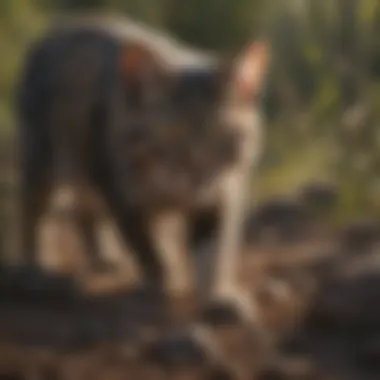
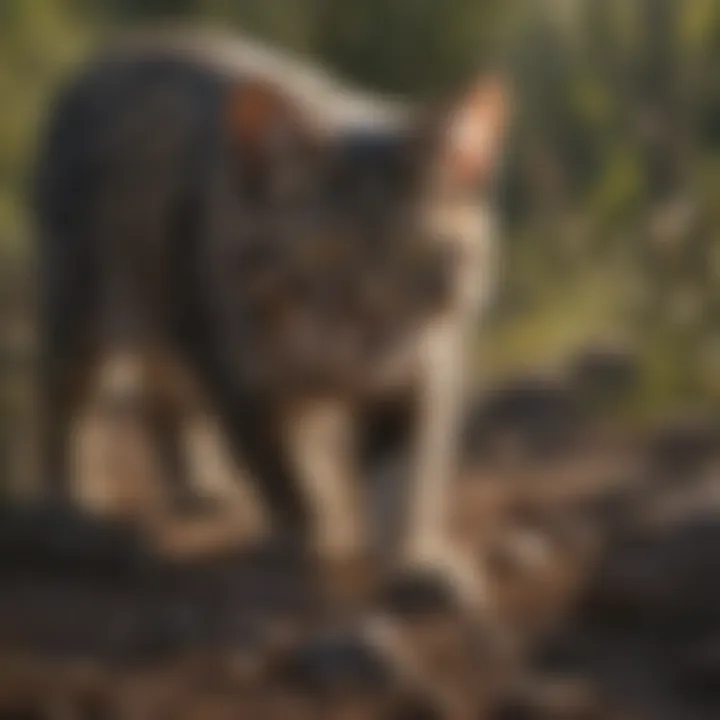
Intro
Feral cats are a significant part of the ecological landscape in Australia. Their presence has raised important questions about biodiversity and conservation. As an introduced species, they have thrived in various environments, but their impact on native wildlife is profound and concerning. This article dives into the ecology of feral cats, examining the complex interplay between their behavior, population dynamics, and management challenges. It aims to inform researchers, educators, and environmental professionals about this pressing issue and explore effective control strategies.
Article Overview
Summary of Key Findings
Feral cats have a notable influence on Australia's ecosystems. Key findings include the following:
- High predation rates on native species, particularly birds and small mammals.
- Rapid population growth due to adaptability and limited natural predators.
- Significant competition with native carnivorous species, leading to a decline in their populations.
These findings highlight the urgency of addressing the feral cat issue to protect Australia's unique biodiversity.
Research Objectives
The objectives of this research include:
- To analyze the ecological role of feral cats within Australian ecosystems.
- To assess the implications of cat predation on native wildlife.
- To evaluate current management practices and propose more effective strategies.
By focusing on these areas, the research aims to provide a comprehensive understanding of how feral cats affect the environment and inform potential solutions.
Key Results and Discussions
Main Findings
The research indicates that feral cats pose a critical threat to many species. Notable observations are:
- Feral cats are responsible for the decline of several endemic species.
- They exploit various habitats, from forests to urban areas, indicating their adaptability.
- The impact of feral cats is compounded by other threats, such as habitat destruction and climate change.
These factors contribute to the urgency of implementing targeted control measures.
Implications of Findings
The implications from the data gathered are significant and wide-reaching:
- Conservation strategies must prioritize feral cat management alongside habitat restoration.
- Educational campaigns can raise awareness of feral cats' impact on biodiversity.
- Collaborative efforts among researchers, government, and local communities are essential for effective management.
Addressing the feral cat issue requires a nuanced understanding of ecology and proactive collaboration among stakeholders.
Through a thorough analysis of feral cats in Australia, this article aims to equip a diverse audience with the knowledge necessary to address this invasive species effectively.
Prelims to Feral Cats in Australia
Feral cats represent a significant ecological concern in Australia, drawing attention from researchers, conservationists, and policymakers alike. Understanding feral cats' role within Australian ecosystems is crucial for addressing the challenges they pose to native wildlife. This section offers insights into the feral cat phenomenon and its implications for biodiversity.
Definition of Feral Cats
Feral cats are domesticated cats that have returned to a wild state. They are typically born in the wild or have been abandoned, leading to the establishment of populations outside the control of humans. These cats display behaviors similar to their wild ancestors, including hunting and territoriality. Unlike strays, who may seek human interaction, feral cats tend to avoid contact with people entirely.
The little management these cats receive from humans contributes to their rapid population growth. Feral cats can reproduce as early as five months of age, and a single female can produce multiple litters each year.
History of Feral Cats in Australia
Feral cats were first introduced to Australia in the 18th century by European settlers, who brought them along as pets and for pest control. Over time, they adapted to Australian environments, leading to significant population growth. Initially considered beneficial, feral cats soon became a source of ecological disruption, as their predatory behaviors began to impact native species.
Historically, Australian ecosystems evolved without feline predators. The introduction of feral cats caused profound changes, affecting species that had no natural defenses against such hunters. Today, they are recognized as one of the major threats to native fauna, contributing to the decline of various species, many of which are already vulnerable or endangered.
Feral cats have become a permanent and problematic feature of the Australian landscape, making their management imperative for biodiversity conservation.
Ecology of Feral Cats
Understanding the ecology of feral cats is critical to evaluating their role within Australian ecosystems. Feral cats influence a variety of ecological factors, including habitat preservation and native species survival. Their presence poses significant threats to biodiversity and the delicate balance of ecosystems. Thus, examining their habitat preferences, diet, hunting behavior, and population dynamics becomes essential not only for management strategies but also for protecting Australia's unique wildlife.
Habitat Preferences
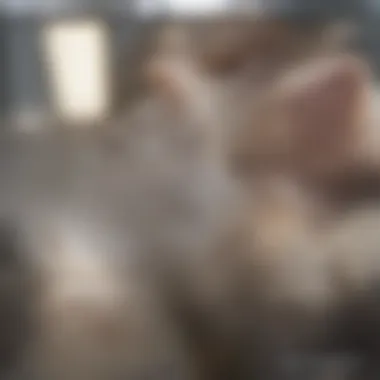

Feral cats (Felis catus) exhibit a range of habitat preferences that enable them to thrive in diverse environments. They are highly adaptable and can be found in various terrains across Australia, from urban areas to remote bushlands. Research indicates that feral cats prefer habitats that provide cover and access to prey. Dense vegetation, such as shrubs and trees, offers concealment for hunting and resting.
The ability of feral cats to exploit human-altered landscapes further increases their numbers. Suburban areas with gardens and parks can become prime environments for these predators. The availability of food sources—like rats and rabbits—alongside suitable cover, makes these areas attractive to feral cat populations. Consequently, understanding where feral cats establish their territories assists in effective management plans.
Diet and Hunting Behavior
The diet of feral cats is varied and opportunistic, encompassing a wide range of prey. Their primary diet consists of small mammals, birds, reptiles, and insects. Feral cats are known for their stealth and agility, which plays a crucial role in their hunting strategies. Typically, they hunt alone or in loosely organized groups, using ambush tactics to capture prey.
Research shows that feral cats have a significant impact on native species due to their predation. Some studies have suggested that feral cats can kill millions of birds and mammals each year. This predatory behavior poses a severe threat to vulnerable species that lack adaptations to evade these introduced predators. Moreover, the hunting patterns of feral cats vary depending on their location and available prey, indicating the need for site-specific studies to assess their impact comprehensively.
Population Dynamics
Feral cat populations are influenced by various factors, including resource availability, environmental conditions, and human intervention. Their reproductive rates are notably high; females can mate multiple times a year, resulting in numerous litters. Factors such as food abundance and habitat quality can lead to population booms, while disease and competition can affect their numbers adversely.
The spatial organization of feral cats tends to be influenced by the availability of resources and territory. Both males and females establish territories, which can overlap. Clustering in resource-rich areas also leads to increased competition, which can stabilize population density in those regions. Understanding these population dynamics is vital for addressing the challenges posed by feral cats.
To mitigate the impacts of feral cats on native wildlife, targeted research on their ecology is essential.
In summary, the study of feral cats underlines their ecological importance in Australia. Recognizing their habitat preferences, dietary habits, and population dynamics provides crucial insights that inform management approaches. Effective mitigation strategies rely on a comprehensive understanding of feral cat ecology to protect vulnerable native species and sustain biodiversity.
Impact on Biodiversity
The impact of feral cats on biodiversity is multifaceted, requiring careful evaluation of their influence on native species and ecosystems. Feral cats are known to be one of the most significant threats to Australia's unique wildlife. Understanding this impact is crucial for developing effective management strategies that aim to mitigate these adverse effects. Importantly, feral cats operate as predators and competitors within their ecosystems, disrupting the balance that sustains various native populations.
Threats to Native Species
Feral cats pose a direct threat to numerous native species, many of which are already vulnerable due to habitat loss and other pressures. They hunt a wide range of animals, including birds, reptiles, and small mammals. This predation leads to declining populations and even extinction in some cases. A 2015 study found that feral cats are responsible for the deaths of over 1 million native animals each day in Australia.
- Endangered Species: Various species such as the Eastern Curlew and the Greater Bilby are experiencing population decline, largely due to predation from feral cats.
- Ecological Imbalance: When native prey species are removed, it disrupts the food web, which can lead to unexpected outcomes for other species.
"The feral cat is an invasive predator that threatens Australia's unique biodiversity. Its presence complicates conservation efforts, as it undermines the survival of many native animals."
Ecosystem Disruption
The presence of feral cats in ecosystems leads to significant disruptions. They are not only predators but also compete with native predators for resources. This competition affects native species' populations and behavior, sometimes resulting in changes in habitat use or reproductive success. Furthermore, the hunting activities of feral cats can lead to alterations in vegetation and soil structure. In particular, the significant decline of ground-nesting birds is a direct consequence of cat predation, impacting plant life as well.
- Altered Species Interactions: With feral cats in the picture, natural predator-prey dynamics get unsettled.
- Loss of Biodiversity: The death of important species leads to further declines, creating a cascading effect throughout the ecosystem.
Case Studies of Impact
Multiple case studies illustrate the severe implications of feral cat populations on Australia's biodiversity. For example, on the smaller islands, feral cats have caused three extinctions of mammal species in the recent past. Rescued remnants of unique species, like the Western Ground Parrot, have seen their numbers dwindle, primarily due to the threats posed by these invasive cats.
- Macquarie Island: A significant reduction of native bird populations was observed, prompting a culling program that drastically reduced the feral cat population.
- Heathlands of South-eastern Australia: The decline of rabbit populations led to increased predation pressure on native species, exacerbating their endangerment.
In summary, feral cats significantly threaten Australia's diverse fauna and flora by preying on and competing with native species, disrupting ecosystem balance, and causing a ripple effect that resounds through the ecological chain. Understanding these impacts forms the foundation for instituting thoughtful management strategies.
Management Strategies
Effective management of feral cats in Australia is crucial for mitigating their ecological impact and protecting native wildlife. The presence of feral cats poses significant challenges, and understanding the management strategies available can help create a balanced approach. Management is not only about controlling populations but also involves educating the public and fostering collaborative efforts among various stakeholders.
Control Methods
Controlling feral cat populations involves several methods, each with its own implications. These strategies include:
- Trapping: Live trapping is one of the most commonly employed techniques. It allows for the capture of feral cats without harming them, which can be more humane compared to lethal methods. Once captured, these cats can be adopted, relocated, or humanely euthanized.
- Shooting: This method is often used in remote areas. While it can rapidly reduce numbers, it raises ethical concerns and requires trained personnel to minimize wounding and suffering.
- Fertility control: Immunocontraception is becoming a preferred option. This method can prevent reproduction in local populations, potentially leading to a gradual decrease in numbers over time.
Each method has benefits and drawbacks. The selection of a control method should consider the specific context, including local ecologies and community attitudes toward feral cats.
Public Awareness Campaigns
Awareness campaigns play a pivotal role in the management of feral cats. Educating the public about the impact of feral cats on native species can significantly alter perceptions and encourage responsible ownership. Key aspects include:
- Information dissemination: Using social media platforms, such as Facebook and Reddit, to inform communities about the ecological consequences of feral cats. These platforms can serve as a forum for sharing resources and experiences.
- Community involvement: Engaging local communities in feral cat management efforts empowers them to take action. Workshops, seminars, and volunteering opportunities create a sense of ownership and responsibility.
- Partnerships with schools: Involving students in awareness programs instills a sense of conservation from an early age. Educational initiatives can lead to meaningful changes in future generations' perspectives on wildlife management.
Public awareness is vital for successful management strategies. Well-informed communities can contribute positively to the mitigation of the challenges posed by feral cats.
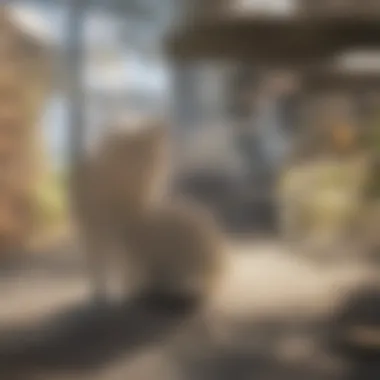

Collaborative Approaches
Collaboration among various stakeholders is essential in managing feral cat populations effectively. This includes partnerships between governmental bodies, non-governmental organizations (NGOs), researchers, and local communities. Collaborative approaches could involve:
- Resource sharing: Organizations can pool resources to develop comprehensive management plans that cover multiple regions, ensuring coordinated actions.
- Joint research initiatives: Researchers can work with practitioners to monitor feral cat populations, assess the impact of control strategies, and share data to improve overall effectiveness.
- Policy advocacy: NGOs and community groups can advocate for policies that support humane and effective management techniques, influencing government actions on feral cat legislation.
Collaborative strategies leverage the expertise and resources of different stakeholders, creating a more comprehensive and effective approach to managing feral cats in Australia.
"Effective management of feral cats requires a multifaceted approach that combines direct control methods with education and community engagement."
In summary, management strategies for feral cats in Australia encompass control methods, public awareness campaigns, and collaborative approaches, each vital for protecting native wildlife and ensuring ecological balance.
Legal Framework and Policy
Understanding the legal framework and policy regarding feral cats in Australia is crucial. This stems from the need to create effective management strategies that align with both environmental conservation and animal welfare. The legislative framework influences how feral cats are categorized, the responsibilities of local authorities, and the implementation of control measures.
Legislation Affecting Feral Cat Management
Various pieces of legislation govern the management of feral cats across Australia. Key regulations include the Environmental Protection and Biodiversity Conservation Act 1999, which safeguards native species threatened by feral cats. Additionally, local laws differ from state to state, often guiding trap-neuter-return (TNR) programs and other management practices. An important aspect is understanding how these laws facilitate the coexistence of feral cat populations with native wildlife.
- National Acts and Policies
- State Regulations
- Environmental Protection and Biodiversity Conservation Act
- Animal Welfare Act
- New South Wales Companion Animals Act
- Queensland Nature Conservation Act
These legislative frameworks not only regulate the control of feral cats but also promote community awareness regarding their ecological impact. Moreover, they establish consequences for breaches that can help ensure compliance and support proactive measures.
Role of Government and NGOs
Government bodies and non-governmental organizations (NGOs) play a significant role in feral cat management. Their involvement spans policy development, research, funding, and education. Collaboratively, they shape programs addressing both feral cat populations and wildlife conservation.
- Government Initiatives: Governments conduct research to understand the ecological impacts of feral cats. They allocate funding for programs aimed at reducing feral cat numbers and promoting responsible pet ownership. Local councils often implement strategies that include community engagement and education to improve public perception on feral cats.
- NGO Contributions: Various NGOs focus on raising awareness about the challenges posed by feral cats. They often lead community efforts such as TNR initiatives or wildlife rescue programs. These organizations serve as a bridge between the community and effective feline management practices. Their campaigns strive to foster empathy while highlighting the need for ecological balance.
Human Interactions with Feral Cats
Understanding human interactions with feral cats is crucial when discussing their impact on the Australian ecosystem. These interactions shape both perceptions and actions towards this invasive species, influencing management practices and policies. The coexistence or conflict between humans and feral cats is not merely a local issue, but one with broader ecological and ethical ramifications.
Community Attitudes
Community attitudes towards feral cats significantly vary across different regions in Australia. Some people see feral cats as a threat to native wildlife and advocate for their control, while others view them with sympathy due to their struggles in the wild.
- Negative Attitudes: Many conservationists and ecologists highlight the ecological damage caused by feral cats. They contribute to the decline of native species, leading to increased support for culling or trapping.
- Positive Attitudes: Conversely, some community members promote the idea of feral cats as part of the urban landscape, appreciating their presence and advocating for humane management solutions instead of eradication.
In debates regarding feral cat management, these attitudes can influence policy. Understanding the reasons behind these beliefs allows stakeholders to target educational efforts better and foster a balance between wildlife conservation and community sentiments.
Ethical Considerations
The ethical considerations surrounding feral cats are complex. Discussions often center on the balance between animal welfare and ecological responsibility. Key points to consider include:
- Welfare of Feral Cats: There is a growing concern for the well-being of feral cats. Methods of control must be humane and consider the suffering of individual animals. Solutions like Trap-Neuter-Return (TNR) programs aim to manage populations while ensuring the well-being of the cats themselves.
- Ecological Responsibility: On the other hand, the ecological impact of feral cats necessitates a discussion on the human responsibility to protect native species. The loss of biodiversity caused by feral cats raises questions about the justifications for allowing their presence in Australia.
Ultimately, the interaction between human values and scientific understanding is pivotal. Responsible management plans must navigate these ethical dilemmas, ensuring that both the welfare of feral cats and the need for ecological balance are respected.
"The challenge lies in finding strategies that satisfy both conservation goals and community welfare concerns."
These discussions are vital as they shape the future of feral cat management in Australia. By exploring community attitudes and ethical considerations, stakeholders can work towards more informed and nuanced approaches to this multifaceted issue.
Scientific Research on Feral Cats
Scientific research on feral cats is essential for understanding their role and impact in Australia's unique ecosystem. Feral cats, as an invasive species, pose significant threats to native wildlife. Ongoing research informs management strategies, enabling effective control measures that are crucial in preserving biodiversity. The complexities surrounding feral cat populations necessitate rigorous study to discern their ecological dynamics, behavioral traits, and interactions with other species. Furthermore, the findings from scientific investigations can lead to improved policies and targeted conservation efforts.
Recent Findings
Recent studies on feral cats have yielded significant insights. Researchers have explored various aspects including:
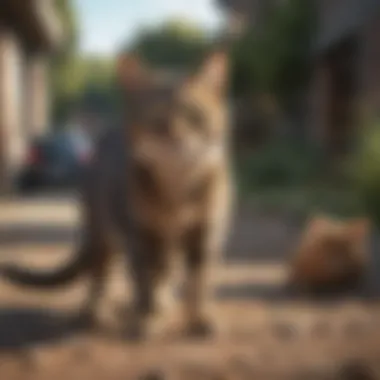
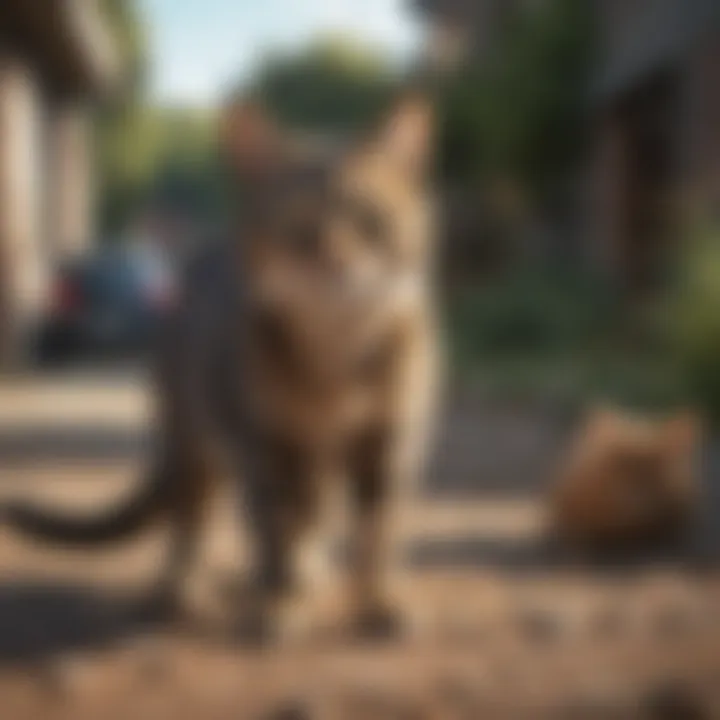
- Population Size and Distribution: Studies reveal high densities of feral cats in specific habitats. They tend to thrive in environments with abundant resources, which directly impacts local fauna.
- Dietary Habits: Analysis of fecal samples has shown that feral cats primarily prey on small mammals, birds, and reptiles. This predation pressure severely affects vulnerable native species, leading to declines in their populations.
- Behavioral Patterns: Observations suggest that feral cats exhibit flexible hunting strategies. Such adaptability allows them to exploit different ecological niches, complicating management efforts.
These findings not only underscore the ecological threats posed by feral cats but also highlight the importance of tailored management techniques based on empirical data.
Implications for Future Research
The implications of recent research on feral cats are profound. Future research should focus on several key areas:
- Longitudinal Studies: More long-term data is required to track population changes and assess the effectiveness of management strategies over time.
- Impact Assessment on Biodiversity: Detailed studies are needed to evaluate the direct effects of feral cat predation on specific native species, particularly those that are already threatened.
- Integration of Technology: Utilizing technologies such as GPS tracking and camera traps can provide deeper insights into feral cat behavior and habitat use, offering more precise data for conservation strategies.
"Understanding feral cats is crucial for designing effective management strategies that preserve Australia’s unique wildlife."
In summary, the research surrounding feral cats is invaluable. It lays the groundwork for better management decisions and contributes to the protection of Australia's biodiversity.
Conservation Efforts
Conservation efforts related to feral cats in Australia are crucial. These efforts are not only about control of feral cat populations but are also essential for the protection of native wildlife and ecosystems. Feral cats inherently disrupt the delicate balance of these ecosystems. Understanding the implications of these disruptions is vital for implementing successful conservation strategies.
Effective conservation strategies necessitate interdisciplinary approaches. Collaboration among ecologists, local communities, and government entities is important. This integration helps in sharing knowledge and resources. They can formulate plans that address not only the cats but also the specific needs of endangered species.
Strategies for Protecting Native Wildlife
One of the primary goals of conservation efforts is to safeguard native wildlife from the threat posed by feral cats. Several methods have been proposed and are being implemented:
- Habitat Restoration: Restoring degraded habitats can create a more favorable environment for native species, making it more challenging for feral cats to thrive.
- Exclusion Fencing: In targeted areas, exclusion fencing has been built to keep feral cats out. Such measures can be effective, especially for breeding and feeding grounds of endangered species.
- Targeted Culling: Though controversial, culling remains a strategy in some regions. When done ethically and responsibly, culling can significantly reduce local feral cat populations.
Protection plans must be tailored to local environments. Factors such as climate and ecosystem type play critical roles in determining the best strategies. Monitoring and evaluations are essential for adapting these strategies over time.
Integrative Conservation Approaches
Integrative conservation approaches bring together multiple aspects of ecology and community involvement. These methods are holistic and take into account the wider ecological context:
- Community Involvement: Engaging local communities in conservation efforts is vital. Community education programs can improve public awareness about the impacts of feral cats and support for protective measures.
- Research Collaboration: Ongoing research into the behavior and ecology of feral cats can inform strategies. Understanding their hunting habits and reproductive patterns can guide management plans.
- Policy Development: It is necessary for policymakers to consider scientific findings in their decisions. New policies that reflect on recent research can help to develop efficient management strategies that benefit both feral cats and native species.
Integrative approaches recognize the interdependence of species within an ecosystem. They emphasize the need for adaptability in management practices. With the right strategies, effective conservation can mitigate the impact feral cats have on native wildlife in Australia.
Maintaining healthy ecosystems is key. Without thoughtful conservation efforts, many indigenous species risk extinction.
In summary, the conservation of wildlife in the presence of feral cats requires strategic planning and execution. These efforts will have lasting effects and foster healthier environments for Australia’s native wildlife.
Future Directions
Future directions in the management of feral Australian cats are crucial. This section will outline the emerging trends and strategies aimed at addressing the challenges posed by feral cat populations. Understanding these directions allows for better preparation and adaptation to changing circumstances. The relevance of this topic cannot be overstated, given the ecological implications of feral cats on native wildlife and biodiversity.
Advancements in Management Techniques
Management techniques for feral cats are evolving. Technological advancements play a significant role. New methods include the use of GPS tracking devices to monitor feral cat movements. This data helps researchers understand their hunting behaviors and habitat preferences. Additionally, innovations in trapping methods also provide more effective ways to control populations. For example, live traps that minimize stress to the cats can improve the effectiveness of relocation efforts.
A key factor in these advancements is collaboration between researchers and communities. Programs that involve local citizens in monitoring and reporting feral cat sightings have shown to be productive. Furthermore, the introduction of more humane euthanasia methods, aligned with ethical standards, is also part of the discourse. This balanced approach aims to reduce the number of feral cats while considering both animal welfare and ecological integrity.
Potential Changes in Public Policy
Public policy is another critical area for future directions. There is a growing advocacy for stricter regulations regarding pet ownership and responsible breeding practices. These changes are recognized as foundational steps in preventing future feral cat populations from emerging. Proposed policies include mandatory sterilization for cats, requiring owners to take accountability for their pets.
In addition to local laws, national policies could also play a role. The integration of feral cat management into broader biodiversity conservation strategies is vital. Government funding support for feral cat studies and control programs is necessary. These changes in public policy can foster a more comprehensive approach to managing feral cat populations.
Striking a balance between ecological needs and community concerns remains integral in shaping effective management frameworks.
Overall, acknowledging these advancements in management techniques and potential policy changes underscores the future directions that will guide the ongoing efforts to address the feral cat issue in Australia. This multifaceted approach is essential to mitigate the ecological impact of feral cats and ensure the protection of Australia's unique wildlife.
End
The discussion surrounding feral cats in Australia highlights several crucial elements. The summary of key points captures the breadth of issues related to feral cats, including their ecological impact and the complexities of management. It is clear that feral cats pose significant threats to native wildlife, disrupt ecosystems, and require a concerted and informed approach to management. This article emphasizes the pressing need for effective strategies that are not only scientifically grounded but also socially accepted among the communities affected by feral cat populations.
Summary of Key Points
- Ecological Impact: Feral cats have a profound impact on biodiversity. They are proficient hunters and contribute to the decline of many native species in Australia, which in turn affects the overall ecological balance.
- Population Dynamics: Understanding the breeding and feeding habits of feral cats is vital for effective management. Their ability to adapt to various environments allows them to flourish in different ecosystems.
- Management Strategies: Several control methods exist, from trapping to public education, highlighting the variety of approaches needed to manage feral cat populations.
- Public Awareness: Community attitudes towards feral cats can shape management outcomes. An informed public can assist in implementing effective strategies and reducing human-wildlife conflicts.
- Legislation: A robust legal framework is necessary to support management efforts and ensure conservation goals are met while balancing human and wildlife needs.
Call for Comprehensive Approaches
To effectively address the challenges posed by feral cats, it is essential to advocate for comprehensive approaches that integrate scientific research, public engagement, and legal measures. The collaboration between government entities, conservation organizations, and the community is paramount. Each stakeholder plays a role in sharing responsibility for developing solutions that are viable and sustainable.
Additionally, future policies must consider the unique ecological context of Australia. This includes implementing strategies that protect native wildlife from the adverse effects of feral cats. By fostering a culture of understanding and cooperation, we can work towards a sustainable coexistence that benefits both wildlife and local communities.







